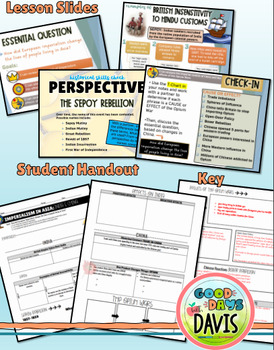Imperialism in Asia: India and China
- PDF
Description
Thank you for downloading this resource!
When you open this file, you will find the google drive link to access all the materials for this lesson so you can copy them to your files.
Included Files:
1. Lesson Slides: There are 26 engaging slides to share content and promote class discussion. This also includes 3 essential questions to guide the lesson, multiple formative check-ins during the lesson, as well as an exit ticket. The .pdf file will retain the intended formatting, but the .pptx file can be edited, however fonts/format may shift or change depending on your device.
2. Student Handout: This 3-page document includes unique guided notes with questions for students to answer during the lecture and discussion.
3. KEY for Student Handout: This key shows sample answers students may give for the guided notes and check-ins.
Hope this helps create another Good Day in your classroom!




